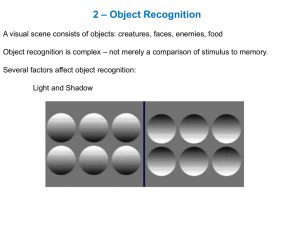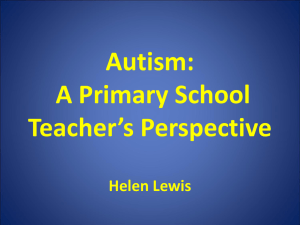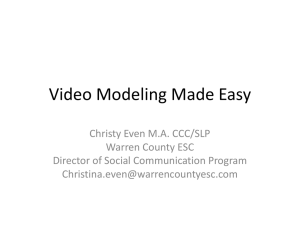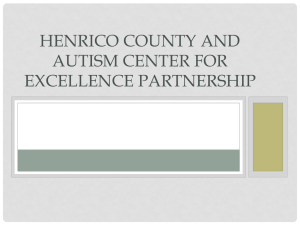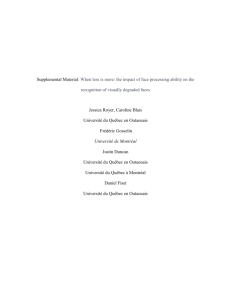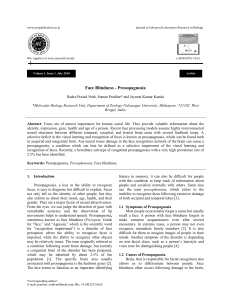Handout 1 - Minnesota School Psychologists Association
advertisement
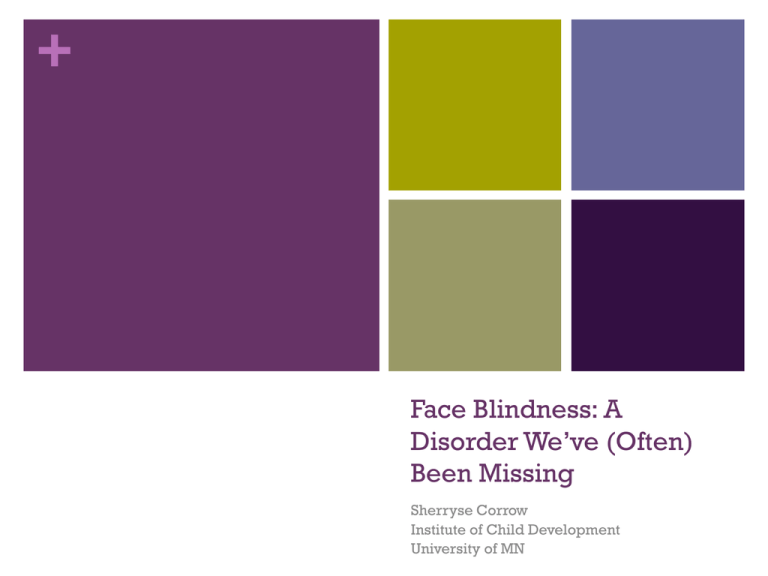
+ Face Blindness: A Disorder We’ve (Often) Been Missing Sherryse Corrow Institute of Child Development University of MN http://researchfestival.nih.gov/festival06/default.htm + Why am I here today? Face Blindness A lot of work investigating face blindness has been done with adults. However, very little work has been done with children. Parent’s of children with DP often find that no one in their state has any information for them about their child’s inability to recognize faces. Researchers Educators Doctors Psychologists + Clarification Face Blindness = Developmental Prosopagnosia (DP) + Outline What is DP? Definition Prevalence Symptoms and Consequences Reasons for Studying DP What causes DP? What do we know about DP in childhood? Case Studies Comorbidities How can we differentiate DP from ASD? How can DP be identified in the classroom and what should be done about it? + What is Developmental Prosopagnosia? Definition, Prevalence, Symptoms, Reasons for Studying DP + What is Developmental Prosopagnosia (DP)? Developmental Prosopagnosia: An inability to recognize faces despite no history of brain damage and intact early visual processing (no visual deficit) and intellectual function (Duchaine & Nakayama, 2006). Courtesy of University of MN “Prosopagnosia is clearly not "face blindness" - people with the condition can see faces fine - what they can't do is distinguish people by their facial features. Faces just seem all the same - in the same way that you might have trouble distinguishing sheep by their faces.” “Take a dozen donuts--all chocolate sprinkles or cinnamon twists. Now look at each one. Note the details - see the curves, the angles of the sprinkles. Name them: George, Susan, Harry, Joe, Billy, etc. Now mix them all up. Who was George? Are you sure? But you saw them in exact detail right? Same thing for me with faces. I see them perfectly, but I can no more tell one face from another than one donut from another - even though they are all different - when they go away and come back.” + Example of Prosopagnosia + Prevalence Prevalence rates of approximately 2% are common around the world. Prevalence: Kennerknecht et al. (2006), Kennerknecht et al., (2008), Bowles et al. (2009), Duchaine, (2008) Image: http://en.loadtr.com/World_Map-483552.htm + Symptoms: There are many symptoms of DP. Failure to recognize someone if they dramatically change their appearance (e.g. hairstyle) or are encountered out of their expected context (e.g. teacher in the grocery store). Reliance on other cues for recognition such as: hairstyle, voice, gait, clothing, context, etc. Little interest in TV shows that portray human characters— Difficulty following the plot. Social Isolation and anxiety. “Four years ago on Christmas Eve we all laughed when he ran to me saying "there’s a strange man at the door!" It was one of my Dad's infrequent visits, my older sons knew it was Grandpa.” “She is 9 years old and has very little friends. We found it interesting that her 2 friends have distinctive looks. One has slightly darker skin and one has a round face.” + Social Consequences (Adults): There are many social consequences of DP that affect the ability to create and maintain friendships. Feelings of embarrassment, guilt, and failure Avoidance of social situations Anxiety Limited employment opportunities Loss of self-confidence Difficulty telling others about DP Dependence on others in social situations Yardley et al. 2008 + Social Consequences (Children): The social consequences of DP in childhood may be even more severe. Limitations in activities and courses (e.g. drama). “Ostracized by peers”– appearing aloof and unfriendly. Unable to maintain social relationships. Concerns about getting lost and being separated from parents or teachers. Extreme difficulty with the transition to middle school (more students, different each hour). Anxiety in the classroom – effect on learning? Diaz, 2008 ” A face blind child does not have the secure feeling to know whether she is talking with someone she knows or a stranger.” “I remember in 2nd grade, not being able to tell Stuart the bully from Jack, the guy who protected me from the bully.” + Why should you be interested in DP? Many cases of DP in childhood, especially mild cases, probably go undiscovered until adulthood (Behrmann & Avidan, 2005; Duchaine & Nakayama, 2006). We need to identify these children earlier in life—hopefully, even the mild cases. By accomplishing this task, we can better understand the disorder so that the social and safety consequences can be alleviated. + What causes DP? Experiential Factors, Neurological Factors, Genetic Factors + Experience Based Theories Could early deprivation lead to DP? Children deprived of all visual input in the first few months of life show a configural-deficit in face processing (Le Grand et al. 2001, 2003, & 2004). Le Grand et al. 2003 Nytimes.com Children who are raised in instutionalized settings (Pollack et al., 2010) or who are extremely shy (Brunet et al. 2010) show slight deficits in face processing. + Neurologically Based Theories Is DP a result of inadequate development of the cortex? http://labnic.unige.ch/nic/htms/fmri.html Haxby et al. 2001 It is possible that some are born with a deficit in or lack of the proper functioning of a neural mechanism needed to properly encode face information. The Fusiform Face Area, is a portion of the fusiform gyrus that is associated with face recognition in adults. The findings are mixed. It may be that some with DP have a neurological deficit and others do not. + Genetics Based Theories Is face recognition inherited from our parents? This is the most widely accepted theory in the literature. Many investigators have reported cases in which many family members will have DP (e.g. Duchaine et al., 2007). Wilmer et al. (2010) reported a higher concordance rate of face recognition skills in identical twins (0.70) than fraternal twins (0.29). However, it is unlikely that ALL cases of DP can be explained by genetic factors (Duchaine, 2008). + What do we know about DP in Childhood? Case Studies and Comorbidities + Where is research being done with kids? “Children change schools more often than adults change jobs. Children change classrooms more often than adults change offices. Children are expected to recognize their parents' friends who have no context for the child to know them. Even if a child learns her classmates, when the school year changes, she has to [sometimes] relearn who they are.” + Case Study Details + How can we differentiate DP from ASD? When so many of the criteria are so similar? + Commonalities and Differences How can ASD be distinguished from DP? Commonalities Unusual eye contact (this may not apply to ALL children with DP) Failure to develop peer relationships Lack of spontaneous seeking to share enjoyment Lack of social reciprocity Differences Restricted and stereotyped patterns of behavior, interests and activities. “Our child very often will just reach for a book at school during breaks, recess etc. rather than try to play with anyone. He has a few casual friends, but no close friends. I'm sure it is because he can't find them. He is still very young - early elementary school.” “I was always shy as a child, much more so than I am as an adult. Always being told to look up at people when I spoke to them & to hold my head straight (by my grandmother, no-one else minded) because I tended not to look at their faces I suppose. “ + CAST – Direct Items Does s/he join in playing games with others easily? Is it important to him/her to fit in with a peer group? Does s/he find it easy to interact with other children? Does s/he have friends, rather than just acquaintances? Are people important to him/her? Does s/he make normal eye contact? Questions provided by ARC website. + CAST – Indirect Items Does s/he come up to your spontaneously for a chat? Can s/he keep a two-way conversation going? Does s/he mostly have the same interests as his/her peers? Does s/he appear to have difficulty understanding the rules for polite behavior? Does s/he appear to have an unusual memory for details? Does s/he try to impose routines on him/herself, or on others, in such a way that it causes problems? Questions provided by ARC website. + CAST – Non-DP Items Does s/he tend to take things literally? Can s/he read appropriately for his/her age? Does s/he have an interest which takes up so much time that s/he does little else? Questions provided by ARC website. + So what?? What does it mean? Are ASD and DP really different? Is DP a version of ASD, representing a particular location on the spectrum? (Problem: many adults with DP do not have ASD). What about children who CLEARLY have an ASD but still cannot recognize faces? Which comes first, the chicken or the egg? What about kids who are just shy of an ASD diagnosis? + How can DP be identified in the classroom and what should done about it? + How to Identify DP in a Child Things to Look For How to Test for DP Social isolation and anxiety. NEPSY “Mistakes” in recognizing classmates. WMS Discrepancy between behavior at home and at school. KABC Similar to high functioning ASD but lack of stereotyped or restricted behaviors. CMS Home-made Tests Name tags = Change in behavior? Mismatch between intelligence and social skills A word of caution . . . + identical (easy) test harder hardest + A word of caution . . . + Adapting the Learning Environment Training Face Recognition Training studies with individuals with DP have been few and far between. DeGutis et al. (2007) successfully trained an adult to recognize faces. Two children have been trained to recognize photographs of familiar faces but the effects did not generalize to other people. A pilot study of a training program in our lab may be effective. + Adapting the Learning Environment Encouraging Effective Coping Strategies Have the children in the classroom wear name tags (problem: good for elementary but not middle or high school). Schedule one-on-one time between the child and other students. Face Blindness is a form of “blindness” to a certain degree. Identify yourself when you approach the child. Maintain a picture set of students in the classroom with key identifiers written on the back of each one. + Summary Knowledge of DP in both applied and research fields is very limited. DP is much more prevalent than we once believed. The social effects of the disorder are problematic for both children and adults. These children need to be identified, and their needs addressed, before the cumulative effects of the disorder become too severe. + Resources Our Lab: Yonas Visual Perception Lab, University of Minnesota, yonaslab@umn.edu, (612) 626-4344. Our Harvard Collaborators: www.faceblind.org CNN Article on Face Blindness: http://articles.cnn.com/2007-0202/health/face.blindness_1_prosopagnosia-blindness-fusiformgyrus?_s=PM:HEALTH National Institute of Heath: http://www.ninds.nih.gov/disorders/prosopagnosia/Prosopagn osia.htm Yahoo Face Blind Group: http://tech.groups.yahoo.com/group/faceblind/ Just for Fun: You Don’t Look Like Anyone I Know by Heather Sellers + Thank you!!! QUESTIONS?

